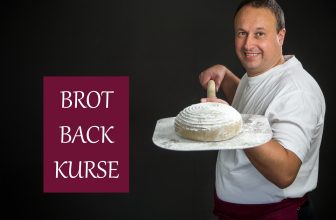
That store-bought baguette? Bland and forgettable compared to homemade sourdough French bread with its magical depth of flavor.
Traditional sourdough French bread intimidates many home bakers – that elusive crispy crust and perfect open crumb seem impossible to achieve. The frustration of dense, flavorless loaves stops here.
Time to learn the exact techniques and create authentic bread with that signature crackling exterior and tangy, airy interior – no professional equipment needed.

Table of Contents
What Is Sourdough French Bread?
Unlike regular baguettes that use commercial yeast for a quick rise, sourdough French bread relies on a living starter culture – that bubbling mixture of flour, water, and wild yeasts that gives the bread its distinctive tangy flavor. The fermentation process stretches 24-48 hours, during which beneficial bacteria break down the flour, making the bread more digestible while developing those complex flavor notes.
The “French” part comes through in its shape and that crackling, caramelized crust that shatters when broken – typically formed into baguettes or batards (shorter, wider loaves). Inside, you’ll find an open, airy crumb that contrasts beautifully with the crisp exterior.
Flour-wise, sourdough French bread typically uses white flour with perhaps a touch of whole wheat, staying true to French traditions while embracing the sourdough method.
It’s like the sophisticated cousin in the bread family – combining French elegance with sourdough’s depth and nutritional benefits. The result? A loaf that’s both rustic and refined, with more personality than regular French bread but perhaps less assertiveness than some American sourdoughs.
Ingredients You’ll Need
For two medium-sized sourdough French baguettes, you’ll need:
- 200g (about 1 cup) active sourdough starter
- 500g flour (400g bread flour + 100g all-purpose flour)
- 350g (1½ cups) filtered water, lukewarm (about 80°F)
- 10g (2 teaspoons) fine sea salt
I’ll revise the section to include subsections for each time period of the sourdough starter creation process.
Related: How to Make Pain de Campagne (French Country Bread)
How to Make a Sourdough Starter
This living culture of wild yeasts and beneficial bacteria becomes your secret weapon for incredible sourdough French bread.
Day 1: Birth of Your Starter
Mix 50g whole wheat flour with 50g lukewarm filtered water in a clean glass jar. Stir vigorously with a wooden spoon to incorporate air. Cover loosely and leave at room temperature.
Day 2: The Waiting Game
You might not see much activity yet – that’s normal! Discard half the mixture and feed with 50g all-purpose flour and 50g water. Stir well and return to its spot.
Days 3-4: Signs of Life
Continue the daily discard-and-feed ritual. You should start noticing bubbles forming and a slightly sour aroma developing. This means the wild yeast colonies are multiplying!
Days 5-7: Growing Strength
Keep up with feedings. Your starter should become more active each day, with more consistent bubbling and a pleasant tangy smell.
Day 7+: Ready for Action
Your starter should now double in size within 4-8 hours after feeding – that’s your cue it’s ready for baking!
Storage & Maintenance
Once established, your starter is remarkably resilient. Store it in the refrigerator and feed it just once a week if you’re not baking regularly. When bread-making day arrives, take it out 1-2 days before, feed it twice at room temperature, and watch it spring back to life!
Mixing and Autolyse
For sourdough French bread, aim for 70-75% hydration to achieve an open crumb while maintaining proper shape. Mix gently by hand until no dry flour remains – excessive kneading isn’t necessary as the long fermentation will develop the gluten naturally.
After mixing, implement an autolyse period of 30 minutes to 2 hours. This rest allows enzymes in the flour to break down starches into sugars while gluten forms effortlessly. For best results, mix your starter and water first, then add flour and rest. Add salt only after autolyse completes, as it can inhibit enzyme activity.
Your dough is developed correctly when it pulls away from the bowl sides but sticks slightly to the bottom, stretches thin without immediately tearing (the “windowpane test”), and develops a smooth surface with a subtle sheen. These visual and tactile cues are more reliable than strictly following recipe timing.
This simple autolyse step significantly improves your bread’s texture, flavor, and overall structure with minimal effort, making it one of the most powerful techniques in your sourdough arsenal.
Bulk Fermentation
After mixing and autolyse, it’s time for bulk fermentation – where your dough truly comes alive. This crucial stage develops those complex flavors that make your French bread extraordinary.
- Use a clear proofing container – glass or transparent plastic lets you monitor progress from all angles
- Ferment at room temperature for 4-8 hours – summer needs just 4 hours at 78°F, winter could require 7-8 hours at 68°F
- Look for a 50% increase in volume – not triple size! This ensures perfect French bread with that open crumb
- Temperature is the fermentation puppet master – aim for 75-78°F for balanced flavor
- Too cool = endless waiting with minimal flavor – too warm rushes the process before flavors properly develop
- Perform 3-4 gentle stretch-and-folds – do these in the first two hours, then let it rest undisturbed
- Know when it’s ready – 50% volume increase, smooth surface with slight dome, puffy feel with visible tiny bubbles, and rounded edges where dough meets container
Give this stage proper attention, and your loaves will reward you with exceptional texture and taste.
Related: The Most Delicious Sourdough French Toast
How to Shape the Loaf
Shaping transforms your fermented dough into either a round boule or elongated batard – the latter offering that classic French bread profile. On your shaping board, create surface tension by gently cupping your hands around the dough’s edges and pulling underneath in smooth, continuous motions. The dough should feel slightly resistant – that’s perfect tension building.
For proper final proofing, use a banneton basket to provide structure and absorb excess moisture. Dust it generously with rice flour to prevent sticking. For baguettes, a linen couche creates supportive folds between loaves while allowing the crucial slightly dry surface to develop.
Transfer boules and batards seam-side up into bannetons, so your carefully tensioned surface becomes the beautiful top of your finished loaf. For couches, place loaves seam-side down, letting the cloth support the sides.
Scoring and Baking
Scoring isn’t just pretty – it’s how you control your bread’s expansion. Grab your lame (that fancy baker’s blade) and make confident, swift cuts about ¼-inch deep. For that coveted “ear” on your bread, slice at a shallow angle like you’re lifting wallpaper rather than cutting straight down.
Steam is your secret weapon for amazing crust. A Dutch oven works perfectly – just remove the lid halfway through baking. No Dutch oven? Create a steam tray by placing a baking pan on the bottom rack while preheating, then carefully pour boiling water into it after loading your bread.
Crank that oven hot – 450-500°F to start, then lower to 425°F after 15 minutes. The whole process takes about 35-45 minutes, but trust your eyes more than the clock. Perfectly baked bread sounds hollow when tapped and hits around 205°F internally.
The hardest part? Waiting at least 30 minutes before slicing! Your bread is still cooking as it cools. Rush this step, and you’ll crush those perfect air pockets into gummy disappointment.
Serving and Storing
- Slicing: Use a serrated bread knife at least 8 inches long. Hold your loaf on its side and use a gentle sawing motion. Always wait until your bread has completely cooled before slicing.
- Pairing: Sourdough French bread pairs beautifully with high-quality salted butter, herb-infused olive oils, aged cheeses, or hearty stews. The tangy interior balances rich foods, while the caramelized crust complements anything with a hint of sweetness.
- Short-term storage: After cooling completely on a wire rack, store your bread in a bread box to balance airflow while preventing drying out. Alternatively, wrap your loaf in a clean cotton cloth and place it cut-side down on a wooden cutting board. Avoid plastic bags as they’ll soften the crust.
- Long-term storage: Slice before freezing, separating pieces with parchment paper. Frozen slices can go straight into the toaster.
- Refreshing stale bread: Lightly spritz with water and bake at 350°F for 5-10 minutes. Day-old bread also makes excellent French toast, bread pudding, or croutons.
From Starter to Slice
Ready to wow your friends with homemade sourdough French bread? You’ve got this! With your bubbly starter, patient fermentation, and that perfect shaping technique, you’re set for bread magic. Remember, that crackling crust comes from proper scoring and steam—total game-changers. Store it right, and you’ll enjoy your creation for days (if it lasts that long!). You’re no longer just a baker—you’re a sourdough artist creating French bread that’s both rustic and refined.
FAQs
What’s the difference between sourdough and French sourdough bread?
Sourdough bread uses wild yeast and bacteria for fermentation, creating a tangy flavor. French sourdough bread (pain au levain) specifically follows French baking traditions with a less assertive tang, a crackling thin crust, and airy crumb structure. It’s typically shaped into baguettes or batards and uses primarily white flour with perhaps a touch of whole wheat.
What is the French equivalent of sourdough bread?
Pain au levain is the French equivalent of sourdough bread. “Levain” means “leaven” or “starter” in French. Traditional pain au levain follows specific French baking methods, resulting in a more subtle sourness than American sourdoughs, with an emphasis on crisp crust and open crumb structure. It’s typically made with white flour and shaped into classic French forms like baguettes.
Is sourdough French bread healthy?
Yes, sourdough French bread offers several health benefits. The long fermentation process breaks down gluten and phytic acid, making nutrients more bioavailable and the bread more digestible. It has a lower glycemic index than regular bread, helping maintain steadier blood sugar levels. While not gluten-free, many people with mild gluten sensitivities find it easier to tolerate.
What is French sourdough called?
French sourdough is called “pain au levain” (literally “bread with leaven”). This traditional bread uses a natural fermentation starter (levain) instead of commercial yeast. While similar to other sourdoughs, pain au levain typically has a milder tang, emphasizes a crackling crust with an open, airy interior, and follows specific French baking techniques that have been perfected over centuries.







